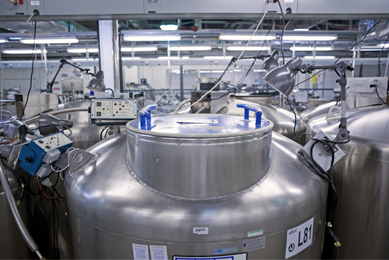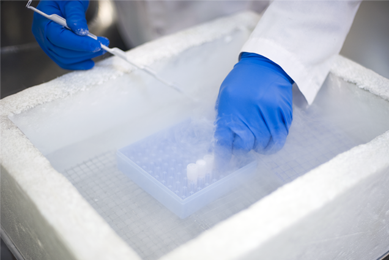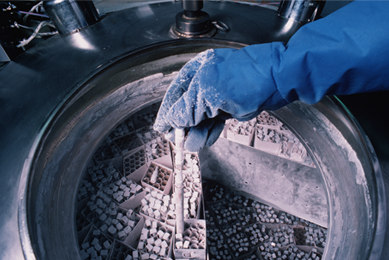Why it’s important
Cryopreservation happens every day in labs all over the world, so there is a good chance that many of the people reading this have cryopreserved cells in their own lab. Given its ubiquity, it is easy to take for granted that it just works; however, simply adding in some DMSO or glycerol and tossing things into the -80°C freezer can cause cellular damage that may not be immediately apparent and can have significant impact on the quality and reproducibility of the studies those cells get used in. Even using more refined cryopreservation techniques—such as controlled-rate freezing—a degree of cellular stress still occurs, often requiring multiple days to weeks in culture after thawing until cells exhibit all their expected phenotypes and behaviors.
What the research shows
One of the areas we are focusing on in cryopreservation research is investigating ways to mitigate the cellular damage caused by the very stressful freeze-thaw process. To do this, we first need to understand why cryopreservation is harmful to cells in the first place.
There are two primary mechanisms for cell injury during cryopreservation. One of these is the physical injury caused by ice crystals forming in and around the cell during freezing and thawing. The second is injury caused by solution hypertonicity that occurs as ice formation sequesters water molecules and concentrates the area outside the growing crystal. Together, these mechanisms are known as the “two-factor hypothesis,” which was first put forward by Peter Mazur in 1972.1
Understanding these mechanisms is key to knowing how to improve. The cryobiology team at ATCC, led by Dr. Nilay Chakraborty, has done significant work in furthering the understanding of these mechanisms and has developed strategies to investigate and modulate cumulative osmotic stress (2008)2 as well as novel preservation approaches exploiting fast transport of water molecules driven by surface tension effects (2018).3
In more conventional cryopreservation settings, the use of additives to the freezing medium to address one or both prongs of the two-factor hypothesis is a well-known strategy to improve outcomes post thaw. When using additives, considering all their potential impacts on the cell, especially at the high concentrations that will occur during freezing, is also important. Evaluating the impact of potential additives on survival of the freeze-thaw process and cell functionality can be tricky due to the many competing factors, however, is critical to optimizing preservation outcomes.
In our research, we often use the THP-1 NF-κB-Luc2 cell line (ATCC TIB-202-NFkB-LUC2) to quickly assess functionality after thawing. The luminescent reporter gene tied to the NF-κB pathway provides an easy method to quickly check whether key cellular functionality is intact after thawing. With the right set of additives and use of a controlled-rate freezer, we have been able to demonstrate that these cells show the same luminescence response within 24 hours after thawing in appropriate culture conditions.
How we can help
Cryopreservation is the underpinning of an incredible amount of research. Being able to send cell lines anywhere in the world or save them for use years down the road and being assured that they will be alive and behaving as expected after thawing is an incredibly powerful tool. At ATCC, we realize the importance of consistency and quality. Understanding and improving cryopreservation helps to ensure that we deliver quality products wherever they need to go.
Did you know?
ATCC's portfolio of cryopreservation materials includes a CoolCell® LX Alcohol-free Cryopreservation Container (ATCC ACS-6000). When used in combination with a -80°C freezer or dry ice locker, this container will provide a freezing rate of -1°C per minute, which supports the safe cryopreservation of most cell lines.
Meet the author
Quinn Osgood, BSE
Lead Biologist, BioNexus Cryobiology, ATCC
Quinn specializes in preservation sciences with 10 years of experience in preservation related research. Quinn received dual BSE in BioEngineering and Mathematics from the University of Michigan. Prior to joining ATCC, Quinn founded a start-up and acquired NSF SBIR funding for the development of a novel dry-state preservation technology and advised a separate start-up on the development of a serum and DMSO free cryopreservation medium for cord blood preservation. At ATCC, Quinn has worked on enabling new product lines through the development of preservation capabilities in both cell biology and microbiology. Quinn also advises on modernization of preservation equipment set up and operation, and he aids in troubleshooting preservation related problems in both R&D and Production.
Explore our related resources
 Poster
Poster
The Need for Standardized Cryoprocessing on Preservation Outcomes
This is a poster presented at ISBER 2023 that explores the need for standardization in freezing processes in cryopreserving biomaterials in production environments.
More Webinar
Webinar
Best Practices in Cryopreservation
In this webinar an ATCC expert taps into ATCC’s vast experience and shares the best practices for cryopreserving cells that ensure optimal results and performance.
More
Cryopreservation Products for Cells
We offer recommended cryoprotectants and techniques to support cells so you experience maximum viability of cells in cell culture, including tools and a line of serum-free cryopreservation media to successfully cryopreserve cell cultures.
MoreReferences
- Mazur P, Leibo SP, Chu EHY. A two-factor hypothesis of freezing injury: evidence from Chinese hamster tissue-culture cells. Exp Cell Res 71(2): 345-355, 1972.
- Elliott GD, Chakraborty N, Biswas D. Anhydrous preservation of mammalian cells: cumulative osmotic stress analysis. Biopreserv Biobank 6(4): 253-260, 2008.
- Solocinski J, Osgood QA, Rosiek E, Underwood L, Zikanov O, Chakraborty N. Development of a surface tension mediated technique for dry stabilization of mammalian cells. PLoS One 13(3): e0193160, 2018.